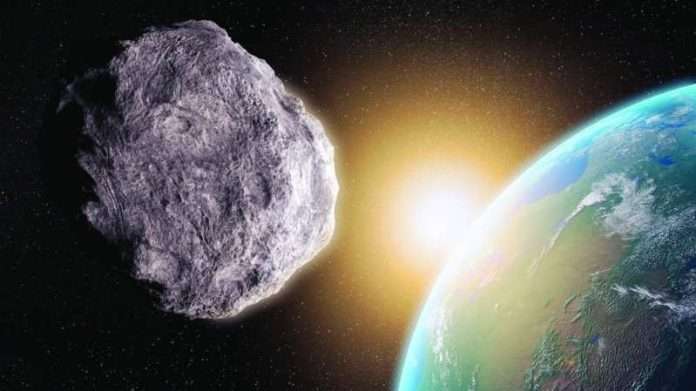Latest News
- Kuwait, Oman Sign A Nurse Training Agreement
- Saudi Arabia And Kuwait Share The Durra Field
- Citizen Detained For Alleged Involvement In Terrorist Plot
- Student Beaten By Teacher, Insulted
- MoH Issues New Drug Pricing Regulations
- On International Labor Day, Kuwait Affirms Its Commitment To Wor...
- MEW's Water & Power Plants Reach 95% Kuwaitization
- Efforts Are Being Made By Kuwait To Cut Subsidies' Waste
- Mobile ID No Longer Displays 'vaccination Status'
- Kuwait Imposes 5,000 Dinar Fines For Unlicensed Or Unrenewed Ads
- National Military Service Authority Delegation Explores Collabor...
- Egypt's President Honors His Highness Amir Sheikh Mishal Al-Ahma...
More Than 30,000 Neas Orbit The Sun On A Trajectory Similar To Earth's.

Astronomers have discovered more than 30,000 Near-Earth Asteroids (NEA) in the Solar System, which are rocky bodies that orbit the Sun on a trajectory that brings it close to Earth’s orbit.
According to the European Space Agency (ESA), there are now a total of 3,039 near-Earth asteroids known to science, and the number is rapidly rising, reports a local Arabic daily.
The European Space Agency claims that 1,425 of these asteroids “can impact” our planet, and are therefore under the “watchful eye” of a network of telescopes.
According to the European Space Agency (ESA), the majority of the 30,000 asteroids have been discovered thanks to technology that is improving rapidly.
“The good news is that more than half of the near-Earth asteroids known today have been discovered in the past six years, which shows how much better our asteroid vision has improved,” said Richard Moisel, head of the European Space Agency’s Planetary Defense Division. Telescopes and new detection methods, it is just a matter of time until scientists find all the space rocks that revolve in a path that brings them close to Earth’s orbit, and they are called Near-Earth Asteroids (NEA), according to what was published by the newspaper “Daily Mail”, and quoted by the site “ Russia Today”.
An asteroid is called a “Near-Earth Asteroid (NEA)” when its path is within 1.3 astronomical units (au) from the Sun. An astronomical unit is the distance between the Sun and Earth (93 million miles), so near-Earth asteroids can be located within a range of at least 0.3 astronomical units, or 45 million kilometers, from the orbit of our planet.
Currently, near-Earth asteroids make up about a third of the nearly one million asteroids discovered so far in the solar system. Most are located in the asteroid belt, the ring-shaped region of the solar system, between Jupiter and Mars.
It is estimated that of the 3,039 new asteroids discovered, about 10,000 are more than 460 feet (140 meters) in diameter, and about 1,000 are more than 3,280 feet (1 km) in diameter, highlighting the need to track these space rocks.
The first near-Earth asteroid ever discovered, called 433 Eros, was first observed by German astronomer Carl Gustav Witt from the Berlin Observatory on August 13, 1898.
The orbit of 433 Eros, which is notorious for its strange, long shape and rocky composition, brings the asteroid to within 13.5 million miles away from Earth – 57 times the distance to the Moon.
In addition to being the first near-Earth asteroid discovered, 433 Eros became the first asteroid to be orbited by a spacecraft and the first to be landed by a spacecraft.
Fortunately, experts can discover the locations of these asteroids and whether they will hit Earth hundreds of years in the future.
It is worth noting that, on average, the Earth collides with a rock the size of a football field every 5,000 years, and an asteroid is capable of ending civilization every million years, according to data from NASA’s Near-Earth Object Program.
In an effort to counter the threat of asteroids that may one day approach our planet and pose a threat to life, NASA has formed a Planetary Defense Program, which includes the Double Asteroid Redirection Test (DART) mission.
DART launched from California last November – and finally completed its 10-month journey when it hit the asteroid Demorphos last month, aiming to slightly change its course.
NASA announced earlier this month that the mission was a success, as the spacecraft managed to shorten Demorphos’ orbit by 32 minutes.
Although Demorphos didn't pose a threat to Earth, the $325 million mission was a test of how Earth would defend itself in the event of a space rock attack.
Get The Latest and important news on our Telegram Channel click here to join
Trending News
-
 Expat Residency Law Amended By Kuwait Ministerial...
20 April 2024
Expat Residency Law Amended By Kuwait Ministerial...
20 April 2024 -
 Two Expats Are Arrested For Stealing From Salmiya...
17 April 2024
Two Expats Are Arrested For Stealing From Salmiya...
17 April 2024 -
 Ministry Announces Separate Time For Amnesty Seeke...
21 April 2024
Ministry Announces Separate Time For Amnesty Seeke...
21 April 2024 -
 Work Permits Will Be Issued For One Year Under The...
27 April 2024
Work Permits Will Be Issued For One Year Under The...
27 April 2024 -
 The Ministry Connects With Violators Of Residency...
23 April 2024
The Ministry Connects With Violators Of Residency...
23 April 2024 -
 Temperature Increases Cause Electricity Load Index...
21 April 2024
Temperature Increases Cause Electricity Load Index...
21 April 2024 -
 3 Expats Caught In Salmiya With 213 Bottles Of Loc...
23 April 2024
3 Expats Caught In Salmiya With 213 Bottles Of Loc...
23 April 2024 -
 AstraZeneca Admits Covid Vaccine Can Cause Rare Si...
29 April 2024
AstraZeneca Admits Covid Vaccine Can Cause Rare Si...
29 April 2024 -
 Al-Nuer Festival Celebrates Kuwaiti Agriculture Wi...
22 April 2024
Al-Nuer Festival Celebrates Kuwaiti Agriculture Wi...
22 April 2024 -
 The Husband Kidnaps His Kids And Travels Back Home
16 April 2024
The Husband Kidnaps His Kids And Travels Back Home
16 April 2024












Comments Post Comment